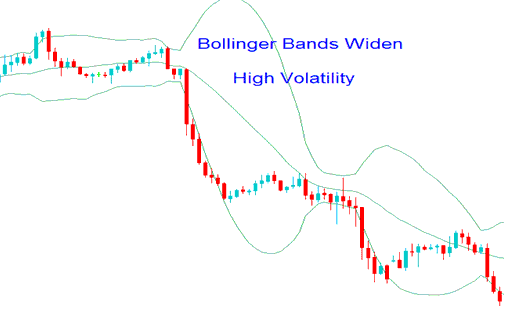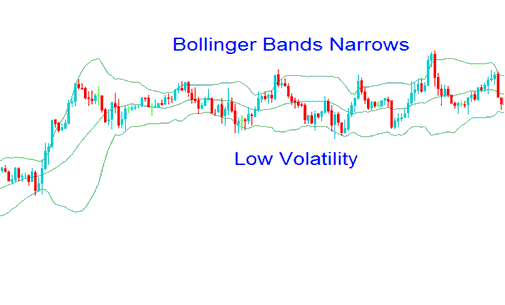Bollinger Bands Indicator & Index Price Volatility
When index price volatility increases, prices tend to deviate significantly from the moving average, causing Bollinger Bands to widen. This expansion accommodates potential price movements within 95% of the mean.
When price volatility increases, the Bollinger Bands indicator will expand. The price will be seen surrounded by the bulging Bollinger band. The market will continue to move in this direction if the Index Bollinger band broadens like this, as it is a continuation Index pattern. Usually, this indicates the ongoing index signal.
The Bollinger band trading indicator illustration exhibited below illustrates and shows the Bollinger bulge.

High Index Price Volatility - Bollinger Bands Bulge
When index prices move little, they hug the moving average. The band narrows, cutting the range where 95% of moves happen around the average.
During periods of low index price volatility, prices often consolidate while awaiting a breakout. When Bollinger Band indicators move sideways, it's advisable to refrain from placing stock index trades.
An illustrative example of the Bollinger Band indicator is provided below, specifically showing a moment when the Index Bollinger Band contracted.

Low Index Price Volatility - Bollinger Bands Squeeze
Get More Tutorials and Lessons and Topics:
- Strategy for Trade IBEX 35
- AS 51 Strategy List and Best AS 51 Trading Strategy to Trade AS51
- How Can You Use Indices a Trendline on Index Trade?
- How to Add Demarker Index Technical Indicator on Trading Chart in MetaTrader 4 Platform
- Why Host Your Expert Advisor(EA) Indices Trade Bots/Robots with VPS Provided by Your Broker Only
- Acceleration/Deceleration (AC) Stock Index Indicator Analysis
- How to Find and Get GDAXI 30 Index on MT5 App
- How to Trade MT5 Fibo Extension on MT5 Platform Software
- Stock Index Trade Tools and Techniques of Indices Equity Management

